Assessing Ecosystem Services in Rubber Dominated Landscapes in South-East Asia—A Challenge for Biophysical Modeling and Transdisciplinary Valuation
Abstract
:1. Introduction
2. Materials and Methods
2.1. Study Area
2.2. Scenario Development
2.3. Selection of ESS, Model Description and Data Integration
2.4. Ecosystem Service Evaluation
3. Results
3.1. Simulated Land Use Changes and Biophysical Model Results
3.2. Scenario Comparisons of Integrated Spatial ESS Supply
3.3. Scenario Comparisons of Temporal Integrated ESS Supply
4. Discussion
4.1. Weighting Methods and ESS Evaluation
4.2. Transdisciplinarity and Ranking of Multiple ESS
4.3. Model Uncertainties
5. Conclusions
Supplementary Materials
Acknowledgments
Author Contributions
Conflicts of Interest
References
- Millenium Ecosystem Assessment. Ecosystems and Human Well-Being: Synthesis; Island Press: Washington, DC, USA, 2005; ISBN 1-59726-040-1. [Google Scholar]
- Daily, G.C.; Matson, P.A. Ecosystem services: From theory to implementation. Proc. Natl. Acad. Sci. USA 2008, 105, 9455–9456. [Google Scholar] [CrossRef] [PubMed]
- Costanza, R.; de Groot, R.; Sutton, P.; van der Ploeg, S.; Anderson, S.J.; Kubiszewski, I.; Farber, S.; Turner, R.K. Changes in the global value of ecosystem services. Glob. Environ. Chang. 2014, 26, 152–158. [Google Scholar] [CrossRef]
- Metzger, M.J.; Rounsevell, M.D.A.; Acosta-Michlik, L.; Leemans, R.; Schröter, D. The vulnerability of ecosystem services to land use change. Agric. Ecosyst. Environ. 2006, 114, 69–85. [Google Scholar] [CrossRef]
- Martínez-Harms, M.J.; Balvanera, P.; Methods, N. Environmental consequences of the demise in swidden cultivation for mapping ecosystem service supply: A review. Int. J. Biodivers. Sci. Ecosyst. Serv. Manag. 2012, 8, 17–25. [Google Scholar] [CrossRef]
- Ziegler, A.D.; Bruun, T.B.; Guardiola-Claramonte, M.; Giambelluca, T.W.; Lawrence, D. Thanh Lamin montane mainland southeast asia: Hydrology and geomorphology. Hum. Ecol. 2009, 37, 361–373. [Google Scholar] [CrossRef]
- Fox, J.; Castella, J.-C. Expansion of rubber (Hevea brasiliensis) in Mainland Southeast Asia: What are the prospects for smallholders? J. Peasant Stud. 2013, 40, 155–170. [Google Scholar] [CrossRef]
- Chen, H.; Yi, Z.-F.; Schmidt-Vogt, D.; Ahrends, A.; Beckschäfer, P.; Kleinn, C.; Ranjitkar, S.; Xu, J. Pushing the limits: The pattern and dynamics of rubber monoculture expansion in Xishuangbanna, SW China. PLoS ONE 2016, 11, 1–15. [Google Scholar] [CrossRef] [PubMed]
- Ahlheim, M.; Börger, T.; Frör, O. Replacing rubber plantations by rain forest in Southwest China—Who would gain and how much? Environ. Monit. Assess. 2015, 187, 1–20. [Google Scholar] [CrossRef] [PubMed]
- Li, H.; Ma, Y.; Liu, W.; Liu, W. Soil changes induced by rubber and tea plantation establishment: Comparison with tropical rain forest soil in Xishuangbanna, SW China. Environ. Manag. 2012, 50, 837–848. [Google Scholar] [CrossRef] [PubMed]
- Wu, Z.-L.; Liu, H.-M.; Liu, L.-Y. Rubber cultivation and sustainable development in Xishuangbanna, China. Int. J. Sustain. Dev. World Ecol. 2001, 8, 337–345. [Google Scholar] [CrossRef]
- Liu, H.; Blagodatsky, S.; Giese, M.; Liu, F.; Xu, J.; Cadisch, G. Impact of herbicide application on soil erosion and induced carbon loss in a rubber plantation of Southwest China. Catena 2016, 145, 180–192. [Google Scholar] [CrossRef]
- Li, H.; Ma, Y.; Aide, T.M.; Liu, W. Past, present and future land-use in Xishuangbanna, China and the implications for carbon dynamics. For. Ecol. Manag. 2008, 255, 16–24. [Google Scholar] [CrossRef]
- Yang, X.; Blagodatsky, S.; Lippe, M.; Liu, F.; Hammond, J.; Xu, J.; Cadisch, G. Land-use change impact on time-averaged carbon balances: Rubber expansion and reforestation in a biosphere reserve, South-West China. For. Ecol. Manag. 2016, 372, 149–163. [Google Scholar] [CrossRef]
- Guardiola-Claramonte, M.; Troch, P.A.; Ziegler, A.D.; Giambelluca, T.W.; Durcik, M.; Vogler, J.B.; Nullet, M.A. Hydrologic effects of the expansion of rubber (Hevea brasiliensis) in a tropical catchment. Ecohydrology 2010, 3, 306–314. [Google Scholar] [CrossRef]
- Li, H.; Aide, T.M.; Ma, Y.; Liu, W.; Cao, M. Demand for rubber is causing the loss of high diversity rain forest in SW China. Biodivers. Conserv. 2007, 16, 1731–1745. [Google Scholar] [CrossRef]
- Cotter, M.; Häuser, I.; Harich, F.K.; He, P.; Sauerborn, J.; Treydte, A.C.; Martin, K.; Cadisch, G. Biodiversity and ecosystem services—A case study for the assessment of multiple species and functional diversity levels in a cultural landscape. Ecol. Indic. 2017, 75, 111–117. [Google Scholar] [CrossRef]
- Meng, L.-Z.; Martin, K.; Weigel, A.; Liu, J.-X. Impact of rubber plantation on carabid beetle communities and species distribution in a changing tropical landscape (southern Yunnan, China). J. Insect Conserv. 2012, 16, 423–432. [Google Scholar] [CrossRef]
- Cotter, M.; Berkhoff, K.; Gibreel, T.; Ghorbani, A.; Golbon, R.; Nuppenau, E.-A.; Sauerborn, J. Designing a sustainable land use scenario based on a combination of ecological assessments and economic optimization. Ecol. Indic. 2014, 36, 779–787. [Google Scholar] [CrossRef]
- Häuser, I.; Thellmann, K.; Cotter, M.; Sauerborn, J. Ecosystem services and biodiversity of rubber plantations—A systematic review. CAB Rev. Perspect. Agric. Vet. Sci. Nutr. Nat. Resour. 2015, 10. [Google Scholar] [CrossRef]
- Pfund, J.-L.; Watts, J.D.; Boissière, M.; Boucard, A.; Bullock, R.M.; Ekadinata, A.; Dewi, S.; Feintrenie, L.; Levang, P.; Rantala, S.; et al. Understanding and integrating local perceptions of trees and forests into incentives for sustainable landscape management. Environ. Manag. 2011, 48, 334–349. [Google Scholar] [CrossRef] [PubMed] [Green Version]
- Sohel, M.S.I.; Ahmed Mukul, S.; Burkhard, B. Landscape’s capacities to supply ecosystem services in Bangladesh: A mapping assessment for Lawachara National Park. Ecosyst. Serv. 2015, 12, 128–135. [Google Scholar] [CrossRef]
- Hu, H.; Liu, W.; Cao, M. Impact of land use and land cover changes on ecosystem services in Menglun, Xishuangbanna, Southwest China. Environ. Monit. Assess. 2008, 146, 147–156. [Google Scholar] [CrossRef] [PubMed]
- Liu, S.; Yin, Y.; Liu, X.; Cheng, F.; Yang, J.; Li, J.; Dong, S.; Zhu, A. Ecosystem Services and landscape change associated with plantation expansion in a tropical rainforest region of Southwest China. Ecol. Model. 2017, 353, 129–138. [Google Scholar] [CrossRef]
- Costanza, R.; D’Arge, R.; De Groot, R.; Farber, S.; Grasso, M.; Hannon, B.; Limburg, K.; Naeem, S.; O’Neill, R.V.; Paruelo, J.; et al. The value of the world’s ecosystem services and natural capital. Nature 1997, 387, 253–260. [Google Scholar] [CrossRef]
- Bateman, I.J.; Brouwer, R.; Ferrini, S.; Schaafsma, M.; Barton, D.N.; Dubgaard, A.; Hasler, B.; Hime, S.; Liekens, I.; Navrud, S.; et al. Making Benefit Transfers Work: Deriving and Testing Principles for Value Transfers for Similar and Dissimilar Sites Using a Case Study of the Non-Market Benefits of Water Quality Improvements Across Europe. Environ. Resour. Econ. 2011, 50, 365–387. [Google Scholar] [CrossRef]
- Koschke, L.; Fürst, C.; Frank, S.; Makeschin, F. A multi-criteria approach for an integrated land-cover-based assessment of ecosystem services provision to support landscape planning. Ecol. Indic. 2012, 21, 54–66. [Google Scholar] [CrossRef]
- Atkinson, G.; Bateman, I.; Mourato, S. Recent advances in the valuation of ecosystem services and biodiversity. Oxf. Rev. Econ. Policy 2012, 28, 22–47. [Google Scholar] [CrossRef]
- Gos, P.; Lavorel, S. Stakeholders’ expectations on ecosystem services affect the assessment of ecosystem services hotspots and their congruence with biodiversity. Int. J. Biodivers. Sci. Ecosyst. Serv. Manag. 2012, 8, 93–106. [Google Scholar] [CrossRef]
- Sharp, R.; Tallis, H.; Ricketts, T.; Guerry, A. D.; Wood, S. A.; Chaplin-Kramer, R.; Nelson, E.; Ennaanay, D.; Wolny, S.; Olwero, N.; et al. InVEST 3.3.3 User’s Guide; The Natural Capital Project: Standford, CA, USA, 2016. [Google Scholar]
- Seppelt, R.; Dormann, C.F.; Eppink, F.V.; Lautenbach, S.; Schmidt, S. A quantitative review of ecosystem service studies: Approaches, shortcomings and the road ahead. J. Appl. Ecol. 2011, 48, 630–636. [Google Scholar] [CrossRef]
- Seppelt, R.; Fath, B.; Burkhard, B.; Fisher, J.L.; Grêt-Regamey, A.; Lautenbach, S.; Pert, P.; Hotes, S.; Spangenberg, J.; Verburg, P.H.; et al. Form follows function? Proposing a blueprint for ecosystem service assessments based on reviews and case studies. Ecol. Indic. 2012, 21, 145–154. [Google Scholar] [CrossRef]
- The Natural Capital Project. How Does It Work? Available online: https://www.naturalcapitalproject.org/how-do-we-know-it-works/#where-we-work (accessed on 25 October 2017).
- Thompson, J.R.; Wiek, A.; Swanson, F.J.; Carpenter, S.R.; Fresco, N.; Hollingsworth, T.; Spies, T.A.; Foster, D.R. Scenario studies as a synthetic and integrative research activity for long-term ecological research. BioScience 2012, 62, 367–376. [Google Scholar] [CrossRef]
- Seppelt, R.; Lautenbach, S.; Volk, M. Identifying trade-offs between ecosystem services, land use, and biodiversity: A plea for combining scenario analysis and optimization on different spatial scales. Curr. Opin. Environ. Sustain. 2013, 5, 458–463. [Google Scholar] [CrossRef]
- Myers, N.; Mittermeier, R.A.; Mittermeier, C.G.; Da Fonseca, G.A.B.; Kent, J. Biodiversity hotspots for conservation priorities. Nature 2000, 403, 853–858. [Google Scholar] [CrossRef] [PubMed]
- Li, Z.; Zhang, Y.; Wang, S.; Yuan, G.; Yang, Y.; Cao, M. Evapotranspiration of a tropical rain forest in Xishuangbanna, Southwest China. Hydrol. Process. 2010, 24, 2405–2416. [Google Scholar] [CrossRef]
- Wehner, S.; Herrmann, S.; Berkhoff, K. CLUENaban—A land use change model combining social factors with physical landscape factors for a mountainous area in Southwest China. Ecol. Indic. 2014, 36, 757–765. [Google Scholar] [CrossRef]
- Xu, J. The political, social, and ecological transformation of a landscape: The case of rubber in Xishuangbanna, China. Mt. Res. Dev. 2006, 26, 254–262. [Google Scholar] [CrossRef]
- Aenis, T.; Wang, J.; Hofmann-Souki, S.; Lixia, T.; Langenberger, G.; Cadisch, G.; Martin, K.; Cotter, M.; Krauss, M.; Waibel, H. Research-praxis integration in South China—The rocky road to implement strategies for sustainable rubber cultivation in the Mekong Region. In River Sedimentation, Proceedings of the 13th International Symposium on River Sedimentation, Stuttgart, Germany, 19–22 September 2016; CRC Press: Boca Raton, FL, USA, 2017; p. 1343. [Google Scholar]
- Aenis, T.; Wang, J. From information giving to mutual scenario definition: Stakeholder participation towards Sustainable Rubber Cultivation in Xishuangbanna, Southwest China. In Farming Systems Facing Global Challenges: Capacities and Strategies; Aenis, T., Knierim, A., Riecher, M.-C., Ridder, R., Schobert, H., Fischer, H., Eds.; Humboldt-Universität zu Berlin, Lebenswissenschaftliche Fakultät: Berlin, Germany, 2016; Volume 1, pp. 618–625. [Google Scholar]
- Naban River Watershed National Nature Reserve Bureau. Naban River Watershed National Nature Reserve (NRWNNR)—Atlas of Ecological Baseline Results; 666100 Jinghong, Yunnan Province, China; NRWNNRB: Jinghong, China, 2014. [Google Scholar]
- Xu, J.; Grumbine, R.E.; Beckschäfer, P. Landscape transformation through the use of ecological and socioeconomic indicators in Xishuangbanna, Southwest China, Mekong Region. Ecol. Indic. 2014, 36, 749–756. [Google Scholar] [CrossRef]
- Ahrends, A.; Hollingsworth, P.M.; Ziegler, A.D.; Fox, J.M.; Chen, H.; Su, Y.; Xu, J. Current trends of rubber plantation expansion may threaten biodiversity and livelihoods. Glob. Environ. Chang. 2015, 34, 48–58. [Google Scholar] [CrossRef]
- Yi, Z.-F.; Cannon, C.H.; Chen, J.; Ye, C.-X.; Swetnam, R.D. Developing indicators of economic value and biodiversity loss for rubber plantations in Xishuangbanna, Southwest China: A case study from Menglun township. Ecol. Indic. 2014, 36, 788–797. [Google Scholar] [CrossRef]
- Marohn, C.; Cadisch, G. Land Use Change Impact Assessment. Available online: https://lucia.uni-hohenheim.de/en/85418 (accessed on 10 October 2017).
- Chang, N.-B.; Wen, C.-G.; Wu, S.L. Optimal management of environmental and land resources in a reservoir watershed by multiobjective programming. J. Environ. Manag. 1995, 44, 144–161. [Google Scholar] [CrossRef]
- Estrella, R.; Cattrysse, D.; van Orshoven, J. Comparison of Three Ideal Point-Based Multi-Criteria Decision Methods for Afforestation Planning. Forests 2014, 5, 3222–3240. [Google Scholar] [CrossRef] [Green Version]
- Uhde, B.; Heinrichs, S.; Stiehl, C.R.; Ammer, C.; Müller-Using, B.; Knoke, T. Bringing ecosystem services into forest planning—Can we optimize the composition of Chilean forests based on expert knowledge? For. Ecol. Manag. 2017, 404, 126–140. [Google Scholar] [CrossRef]
- Bhagabati, N.K.; Ricketts, T.; Sulistyawan, T.B.S.; Conte, M.; Ennaanay, D.; Hadian, O.; McKenzie, E.; Olwero, N.; Rosenthal, A.; Tallis, H.; et al. Ecosystem services reinforce Sumatran tiger conservation in land use plans. Biol. Conserv. 2014, 169, 147–156. [Google Scholar] [CrossRef]
- Polasky, S.; Nelson, E.; Pennington, D.; Johnson, K.A. The impact of land-use change on ecosystem services, biodiversity and returns to landowners: A case study in the state of Minnesota. Environ. Resour. Econ. 2011, 48, 219–242. [Google Scholar] [CrossRef]
- Hamel, P.; Guswa, A.J. Uncertainty analysis of a spatially explicit annual water-balance model: Case study of the Cape Fear basin, North Carolina. Hydrol. Earth Syst. Sci. 2015, 19, 839–853. [Google Scholar] [CrossRef]
- Wischmeier, W.H.; Smith, D.D. Predicting Rainfall Erosion Losses—A Guide to Conservation Planning; USDA, Science and Education Administration: Hyattsville, MD, USA, 1978.
- Sheikh, A.H.; Palria, S.; Alam, A. Integration of GIS and universal soil loss equation (USLE) for soil loss estimation in a Himalayan watershed. Recent Res. Sci. Technol. 2011, 3, 51–57. [Google Scholar]
- Waibel, H.; Min, S.; Huang, J. Small scale rubber farming and income risk in Xishuangbanna, China. In Proceedings of the World Congress on Agroforestry, Delhi, India, 10–14 February 2014. [Google Scholar]
- Nguyen, B.T. Large-scale altitudinal gradient of natural rubber production in Vietnam. Ind. Crops Prod. 2013, 41, 31–40. [Google Scholar] [CrossRef]
- Beckschäfer, P. Obtaining rubber plantation age information from very dense Landsat TM & ETM + time series data and pixel-based image compositing. Remote Sens. Environ. 2017, 196, 89–100. [Google Scholar] [CrossRef]
- Hijmans, R.J.; Cameron, S.E.; Parra, J.L.; Jones, P.G.; Jarvis, A. Very high resolution interpolated climate surfaces for global land areas. Int. J. Climatol. 2005, 25, 1965–1978. [Google Scholar] [CrossRef]
- Hoyer, R.; Chang, H. Assessment of freshwater ecosystem services in the tualatin and Yamhill basins under climate change and urbanization. Appl. Geogr. 2014, 53, 402–416. [Google Scholar] [CrossRef]
- Nelson, E.; Mendoza, G.; Regetz, J.; Polasky, S.; Tallis, H.; Cameron, D.R.; Chan, K.M.A.; Daily, G.C.; Goldstein, J.; Kareiva, P.M.; et al. Modeling multiple ecosystem services, biodiversity conservation, commodity production, and tradeoffs at landscape scales. Front. Ecol. Environ. 2009, 7, 4–11. [Google Scholar] [CrossRef]
- Ahlheim, M.; Frör, O.; Möller, B.; Zhang, Y.; Xi, W. Welfare Economic Valuation of a Sustainable Rubber Production in Southeast Asia: An Exemplary Study in SW-China. In Tropentag 2013 “Agricultural Development within the Rural-Urban Continuum”; Stuttgart-Hohenheim: Stuttgart, Germany, 2013. [Google Scholar]
- Roszkowska, E. Rank ordering criteria weighting methods–A comparative overview. Optim. Stud. Ekon. 2013, 14–33. [Google Scholar] [CrossRef]
- Ochoa, V.; Urbina-Cardona, N. Tools for spatially modeling ecosystem services: Publication trends, conceptual reflections and future challenges. Ecosyst. Serv. 2017, 26, 155–169. [Google Scholar] [CrossRef]
- Felipe-Lucia, M.R.; Comín, F.A.; Escalera-Reyes, J. A framework for the social valuation of ecosystem services. Ambio 2015, 44, 308–318. [Google Scholar] [CrossRef] [PubMed]
- Likert, R. A technique for the measurement of attitudes. Arch. Psychol. 1932, 22, 55. [Google Scholar]
- Saaty, T.L. How to make a decision: The analytic hierarchy process. Eur. J. Op. Res. 1990, 48, 9–26. [Google Scholar] [CrossRef]
- Schmidt, S.; Manceur, A.M.; Seppelt, R. Uncertainty of monetary valued ecosystem services—Value transfer functions for global mapping. PLoS ONE 2016, 11. [Google Scholar] [CrossRef] [PubMed]
- Jiang, W. Ecosystem services research in China: A critical review. Ecosyst. Serv. 2017, 26, 10–16. [Google Scholar] [CrossRef]
- Knoke, T.; Paul, C.; Hildebrandt, P.; Calvas, B.; Castro, L.M.; Härtl, F.; Döllerer, M.; Hamer, U.; Windhorst, D.; Wiersma, Y.F.; et al. Compositional diversity of rehabilitated tropical lands supports multiple ecosystem services and buffers uncertainties. Nat. Commun. 2016, 7, 11877. [Google Scholar] [CrossRef] [PubMed]
- Smajgl, A.; Xu, J.; Egan, S.; Yi, Z.-F.; Ward, J.; Su, Y. Assessing the effectiveness of payments for ecosystem services for diversifying rubber in Yunnan, China. Environ. Model. Softw. 2015, 69, 187–195. [Google Scholar] [CrossRef]
- Kovacs, K.; Polasky, S.; Nelson, E.; Keeler, B.L.; Pennington, D.; Plantinga, A.J.; Taff, S.J. Evaluating the Return in Ecosystem Services from Investment in Public Land Acquisitions. PLoS ONE 2013, 8. [Google Scholar] [CrossRef] [PubMed]
- Tan, Z.-H.; Zhang, Y.-P.; Song, Q.-H.; Liu, W.-J.; Deng, X.-B.; Tang, J.-W.; Deng, Y.; Zhou, W.-J.; Yang, L.-Y.; Yu, G.-R.; et al. Rubber plantations act as water pumps in tropical China. Geophys. Res. Lett. 2011, 38. [Google Scholar] [CrossRef]
- Giambelluca, T.W.; Mudd, R.G.; Liu, W.; Ziegler, A.D.; Kobayashi, N.; Kumagai, T.; Miyazawa, Y.; Lim, T.K.; Huang, M.; Fox, J.; et al. Evapotranspiration of rubber (Hevea brasiliensis) cultivated at two plantation sites in Southeast Asia. Water Resour. Res. 2016, 52, 660–679. [Google Scholar] [CrossRef]
- Cha, Z.-Z.; Lin, Z.-M.; Luo, W.; Li, S.-C.; Luo, X.-H. Sustainable land management practices for rubber plantations in mountainous area of Hainan. Pedosphere 2005, 15, 404–408. [Google Scholar]
- Sánchez-Canales, M.; López Benito, A.; Passuello, A.; Terrado, M.; Ziv, G.; Acuña, V.; Schuhmacher, M.; Elorza, F.J. Sensitivity analysis of ecosystem service valuation in a Mediterranean watershed. Sci. Total Environ. 2012, 440, 140–153. [Google Scholar] [CrossRef] [PubMed]
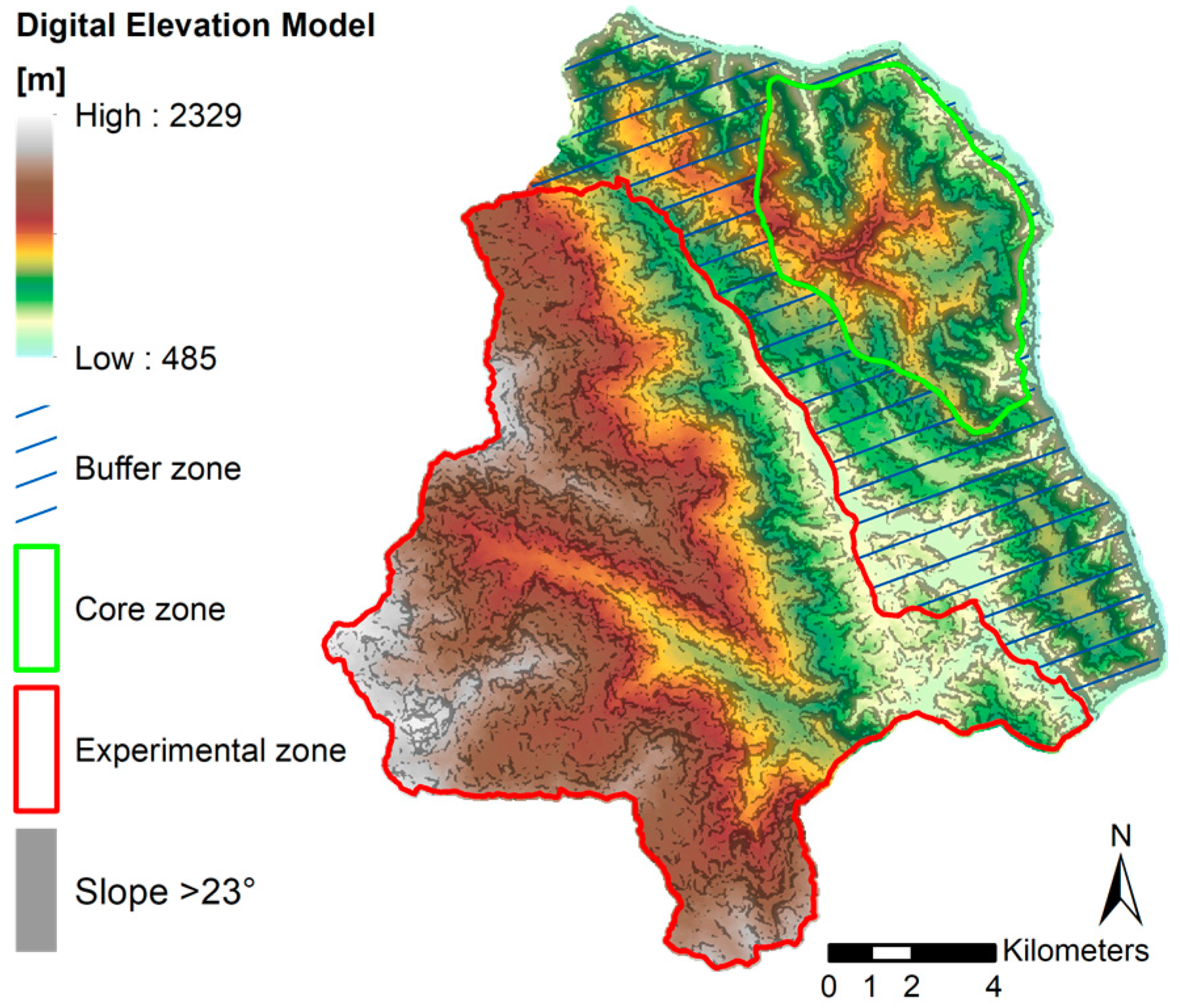
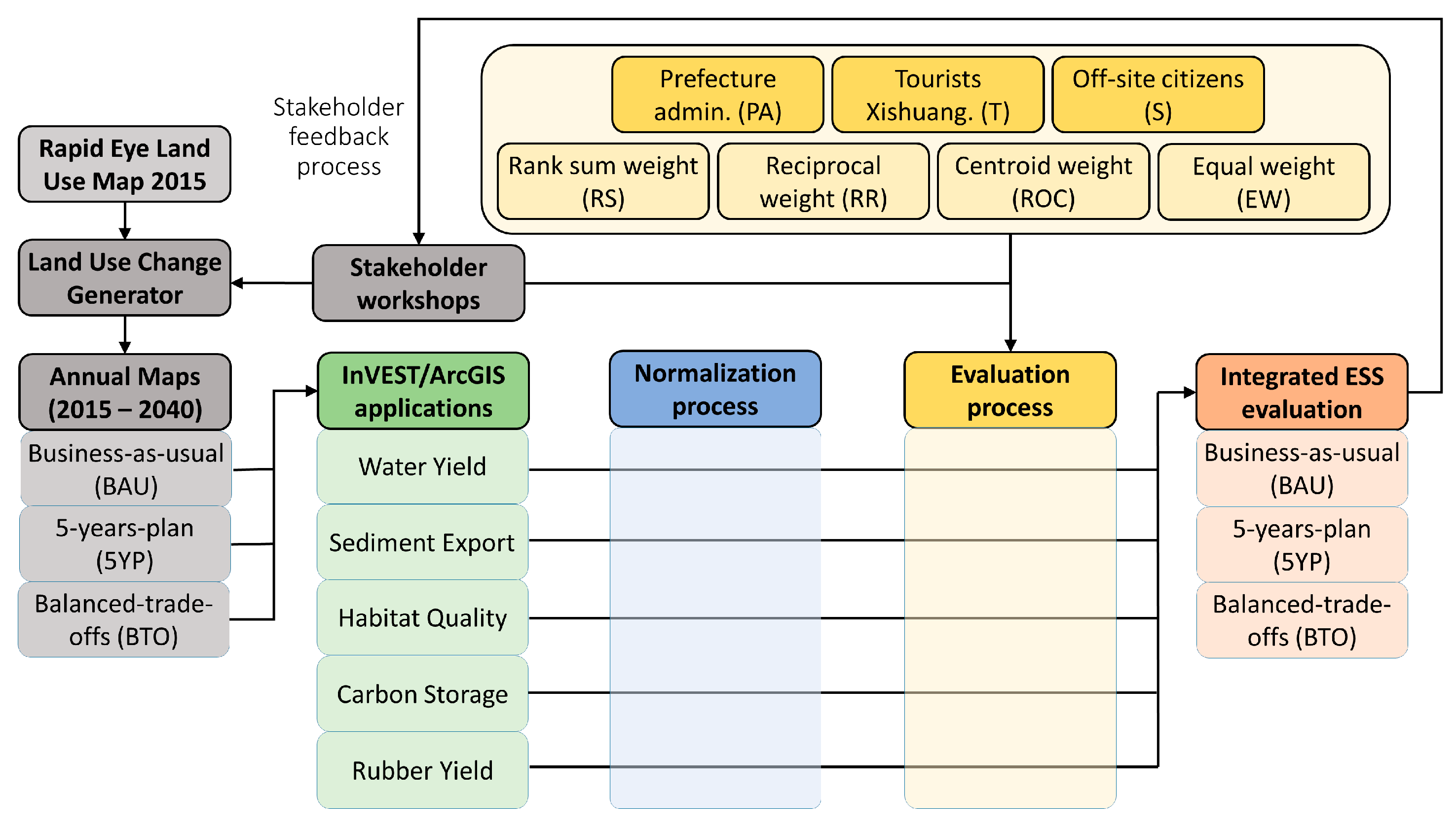
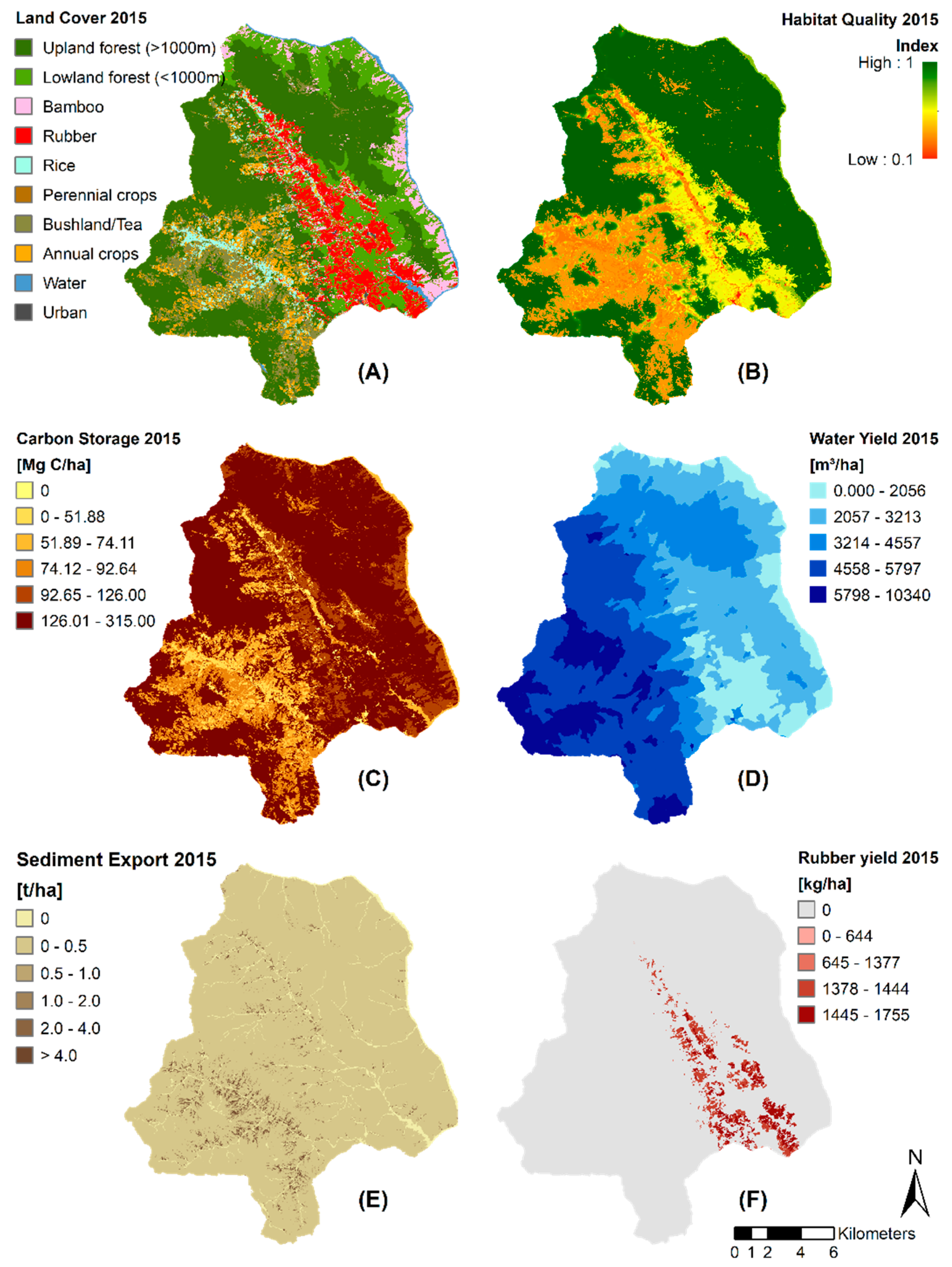
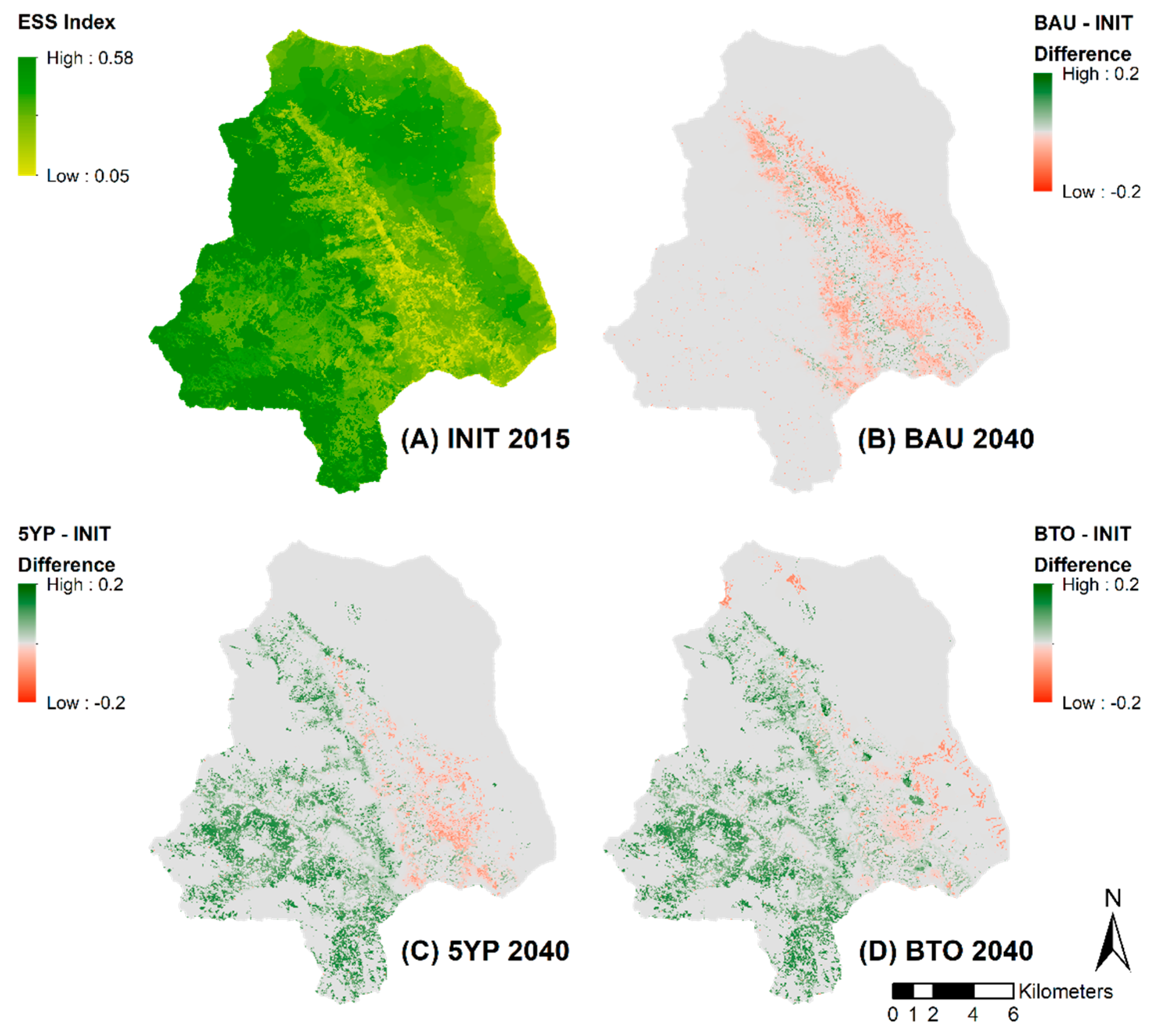
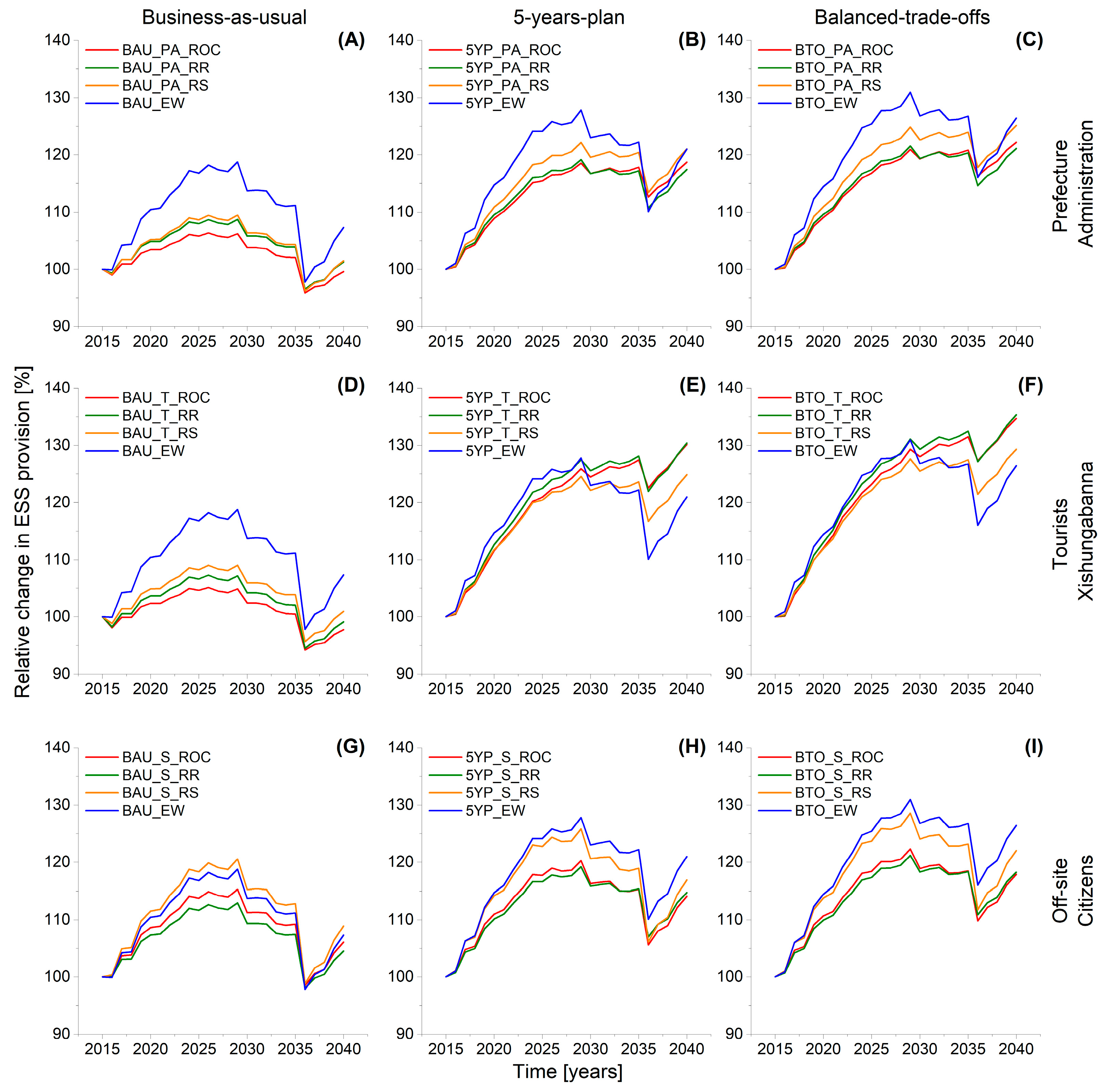
| Land Cover Category | Coverage in 2015 (%) |
|---|---|
| Upland forest 1 | 45.9 |
| Lowland forest 1 | 15.4 |
| Bamboo | 5.8 |
| Rubber | 9.4 |
| Rice | 4.1 |
| Perennial crops | 1.1 |
| Bushland/tea 2 | 8.8 |
| Annual crops | 5.8 |
| Water | 1.3 |
| Urban | 0.4 |
| Rank | ESS and Stakeholder Groups | Weighting Method | |||||
|---|---|---|---|---|---|---|---|
| PA | T | S | RS | RR | ROC | EW | |
| 1 | Water | Soil | Biodiversity | 0.33 | 0.44 | 0.45 | 0.2 |
| 2 | Soil | Biodiversity | Water | 0.27 | 0.22 | 0.26 | 0.2 |
| 3 | Biodiversity | Water | Rubber | 0.21 | 0.14 | 0.16 | 0.2 |
| 4 | Rubber | Rubber | Soil | 0.12 | 0.11 | 0.09 | 0.2 |
| 5 | Carbon | Carbon | Carbon | 0.07 | 0.09 | 0.04 | 0.2 |
| Land Cover Category | Coverage in 2040 (%) | ||
|---|---|---|---|
| Business as Usual (BAU) | 5-Years-Plan (5YP) | Balanced-Trade-Offs (BTO) | |
| Upland forest 1 | 43.7 | 55.3 | 55.7 |
| Lowland forest 1 | 12.6 | 13.5 | 13.4 |
| Bamboo | 5.0 | 5.8 | 5.8 |
| Rubber | 15.2 | 10.4 | 10.5 |
| Rice | 4.1 | 4.1 | 4.1 |
| Perennial crops | 1.1 | 1.1 | 1.1 |
| Bushland/tea 2 | 10.9 | 2.3 | 1.9 |
| Annual crops | 5.8 | 5.8 | 5.8 |
| Water | 1.3 | 1.3 | 1.3 |
| Urban | 0.4 | 0.4 | 0.4 |
| Scenario | Water Yield (km³) | Sediment Export (106 kg) | Habitat Quality (10³ HQ Index) | Dry Rubber Yield (106 kg) | Carbon Storage (106 kg) |
|---|---|---|---|---|---|
| Initial state (2015) | 102 | 53 | 232 | 1.85 | 5337 |
| Business-as-usual (2040) 1 | 99 | 61 | 225 | 2.98 | 5095 |
| 5-years-plan (2040) 2 | 102 | 24 | 248 | 2.52 | 5693 |
| Balanced-trade-offs (2040) 3 | 102 | 19 | 249 | 2.92 | 5693 |
| Stakeholder Group and Weighting Method | Business-As-Usual (BAU) (%) | 5-Years-Plan (5YP) (%) | Balanced-Trade-Offs (BTO) (%) |
|---|---|---|---|
| PA_ROC | 99.60 | 118.71 | 122.16 |
| PA_RR | 101.25 | 117.45 | 121.08 |
| PA_RS | 101.47 | 121.01 | 125.15 |
| T_ROC | 97.76 | 130.15 | 134.71 |
| T_RR | 99.10 | 130.40 | 135.35 |
| T_RS | 100.91 | 124.85 | 129.33 |
| S_ROC | 106.07 | 114.07 | 117.89 |
| S_RR | 104.54 | 114.75 | 118.27 |
| S_RS | 108.91 | 116.90 | 122.01 |
| EW | 107.29 | 120.99 | 126.42 |
© 2017 by the authors. Licensee MDPI, Basel, Switzerland. This article is an open access article distributed under the terms and conditions of the Creative Commons Attribution (CC BY) license (http://creativecommons.org/licenses/by/4.0/).
Share and Cite
Thellmann, K.; Blagodatsky, S.; Häuser, I.; Liu, H.; Wang, J.; Asch, F.; Cadisch, G.; Cotter, M. Assessing Ecosystem Services in Rubber Dominated Landscapes in South-East Asia—A Challenge for Biophysical Modeling and Transdisciplinary Valuation. Forests 2017, 8, 505. https://doi.org/10.3390/f8120505
Thellmann K, Blagodatsky S, Häuser I, Liu H, Wang J, Asch F, Cadisch G, Cotter M. Assessing Ecosystem Services in Rubber Dominated Landscapes in South-East Asia—A Challenge for Biophysical Modeling and Transdisciplinary Valuation. Forests. 2017; 8(12):505. https://doi.org/10.3390/f8120505
Chicago/Turabian StyleThellmann, Kevin, Sergey Blagodatsky, Inga Häuser, Hongxi Liu, Jue Wang, Folkard Asch, Georg Cadisch, and Marc Cotter. 2017. "Assessing Ecosystem Services in Rubber Dominated Landscapes in South-East Asia—A Challenge for Biophysical Modeling and Transdisciplinary Valuation" Forests 8, no. 12: 505. https://doi.org/10.3390/f8120505





